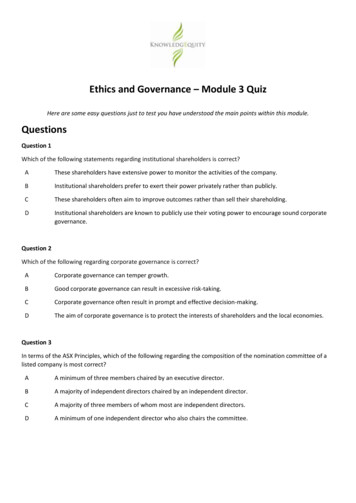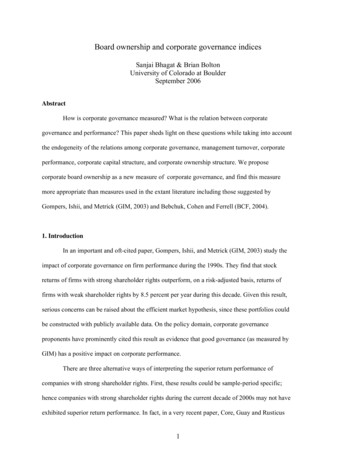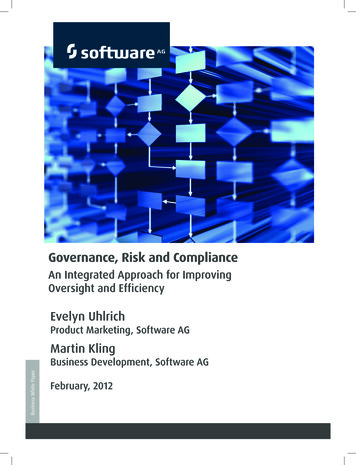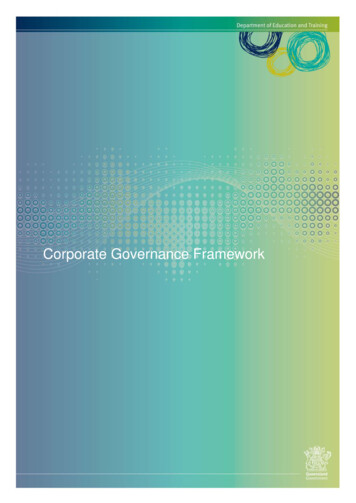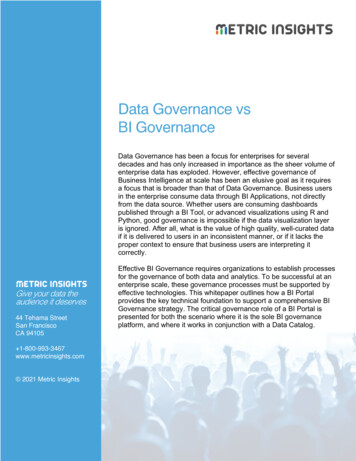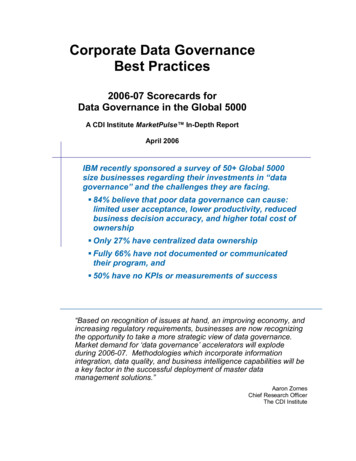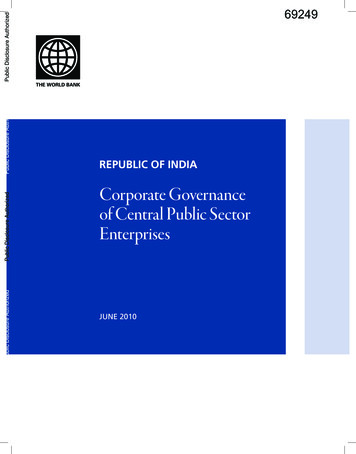
Transcription
Public Disclosure AuthorizedPublic Disclosure AuthorizedPublic Disclosure AuthorizedPublic Disclosure Authorized69249Republic of IndiaCorporate Governanceof Central Public SectorEnterprisesJune 2010
ContentsAcknowledgements. vGlossary.viExecutive Summary. 101. Objectives and Methodology. 502. Context for CPSE Governance. 7A. Brief History of CPSE Reform. 7B. Role and Performance of CPSEs . 9C. Overview of Corporate Governance Framework . 13D. Challenges and Benefits of Governance Reform. 1803. Imposing Market Discipline . 2004. Improving the State’s Ownership Role. 26A. Strengthening Ownership Arrangements . 26B. Exercising Key Shareholder Functions . 3405. Professionalizing CPSE Boards . 42A. Strengthening Board Composition and Structure. 42B. Empowering CPSE Boards . 45C. Strengthening Audit Committees. 48D. Introducing Board Remuneration and Evaluation Systems. 4906. Enhancing Disclosure and Transparency. 52A. Enhancing Disclosure. 52B. Strengthening CPSE Audits . 5507. Next Steps. 57Annex 1: Understanding the Impact of Policy Measures on thePerformance of CPSEs. 59A. The Financial Performance of CPSEs. 59B. Determinants of the Financial Performance of CPSEs. 63C. Ownership and Performance. 64D. Deregulation, Competition and Financial Performance. 66E. Firm Specific Factors and Performance. 66F. The MOU System and Performance. 68
Tables and FiguresTable 1: Main Recommendations. 3Table 2: Top Ten Companies by Income. 10Table 3: Top Ten Profit-Making CPSEs. 10Table 4: Brief History of Public Sector Reforms in India sinceLiberalization in 1991. 11Table 5: Top Ten Loss Making CPSEs. 12Table 6: Breakdown of CPSEs by Ministry. 16Table 7: Board Selection and Appointment Process. 37Table 8: Coverage of MOU System. 39Table 9: Brief history of Memoranda of Understanding System. 40Table 10: CPSEs in the Sample of 25 Companies used in Figures Below. 60Table 11: Companies by Ownership in the Dataset. 65Figure 1: Structure of CPSE Oversight. 15Figure 2: Distribution of SOEs by Sector. 59Figure 3: Sales to National GDP: 1997-2005. 60Figure 4: Annual Sales Growth Rate of all SOEs: 1998-2005. 60Figure 5: Profit of CPSEs to National GDP: 1997-2005. 61Figure 6: Loss of CPSEs to National GDP: 1997-2005. 61Figure 7: Business Costs of Private Companies,1992-2005. 61Figure 8: Business Costs of CPSEs, Sample of 25, 1992-2005. 61Figure 9: Business Costs of Private Companies, 1992-2005. 62Figure 10: Business Costs of CPSEs, 1992-2005Figure 11: Return on Assets of Private Firms and SOEs, 1992-2005. 62Figure 12: Efficiency of Private Firms and SOEs, 1992-2005. 62Figure 13: Return on Sales of Private Firms and SOEs, 1992-2005. 62
AcknowledgementsThis report was prepared by David Robinett, Varsha Marathe, andSunita Kikeri of the World Bank. The report is based on a template/questionnaire completed by Sumant Batra, and additional inputsprovided by Pavithra Suryanarayan, and Pratip Kar, consultants.The Review reflects technical discussions with the Ministry ofHeavy Industries and Public Enterprises, Ministry of Chemicals &Fertilizers, Comptroller and Auditor General, Standing Committeeon Public Enterprises, Bombay Stock Exchange, Confederationof India Industry, Public Enterprise Selection Board, Board forReconstruction of Public Sector Enterprises, and CMDs, directors,and company secretaries of central public sector enterprises. AlexanderBerg, Parminder Brar, Manoj Jain, Dhruba Purkayastha, Vijay Tata/Yesha Yadav, and Chunlin Zhang provided advice and comments.The report incorporates comments received at the “Workshop onDeveloping an Agenda for Corporate Governance” organized by theDepartment of Public Enterprises (DPE) in Delhi, February 15-16,2010. It has been updated to reflect all changes through June 2010.The report has been discussed with the Government of India but doesnot necessarily bear their approval for all its contents, especially wherethe Bank has stated its judgment/opinion/policy recommendations.
GlossaryACC: Appointments Committee of CabinetMCA: Ministry of Company AffairsBIFR: Board for Industrial and FinancialReconstructionMHI&PE: Ministry of Heavy Industry andPublic EnterprisesBPE: Bureau of Public EnterprisesMoF: Ministry of FinanceBRPSE: Board for Reconstruction of PublicSector EnterprisesMoU: Memorandum of UnderstandingCA: Companies ActC&AG: Comptroller and Auditor Generalof IndiaCBI: Central Bureau of InvestigationNCMP: National Common MinimumProgrammeNIF: National Investment FundPESB: Public Enterprises Selection BoardPIB: Public Investment BoardCG Guidelines: Corporate GovernanceGuidelines issued by the DPEPMA: Permanent Machinery of ArbitrationCPSE: Central Public Sector EnterprisePSU: Public Sector UndertakingCVC: Central Vigilance CommissionerRIA: Right to Information ActDPE: Department of Public EnterprisesSCOPE: Standing Conference of PublicEnterprisesFCI: Food Corporation of IndiaGoI: Government of IndiaGRI: Global Reporting InitiativeHPC: High Power CommitteeICAI: Institute of Chartered Accountantsof IndiaIFRS: International Financial ReportingStandardsIPO: Initial Public OfferingSC/ST: Scheduled casts/scheduled tribesSEBI: Securities Exchange Board of IndiaSICA: Sick Industrial Companies (SpecialProvisions) Act, 1985CPSE: State Owned EnterpriseUNGC: United Nations Global CompactVRS: Voluntary Retirement Scheme
Corporate Governance of Central Public Sector EnterprisesExecutive SummaryThe Government of India (GOI) has taken a number of steps over the years to improve the efficiencyand performance of its Central Public Sector Enterprises (CPSEs). Corporate governance has been animportant part of GOI’s broader CPSE and economic reforms, aimed at improving the performanceand competitiveness of some of India’s most important national assets, allowing companies easier accessto the capital markets, and making companies more transparent and accountable. The underlying goalis to reorient the state’s role away from a market player to a market regulator and away from day-to-daymanagement of CPSEs towards exercising its core ownership rights based on sound corporate governanceprinciples.To this end, the Department of Economic Analysis (Ministry of Finance) and the Department ofPublic Enterprises (Ministry of Heavy Industry and Public Enterprises) requested World Bank supportin assessing CPSE corporate governance in light of good practice based on the OECD Guidelines onCorporate Governance of State-Owned Enterprises, and in light of India’s own Guidelines on CorporateGovernance of State-Owned Enterprises issued in 2007. This report carries out the review and offersrecommendations for improving CPSE governance. It is based on a review of the legal and regulatoryframework, the findings and reports carried out by various government commissions and expert groupson CPSEs, background research on CPSE performance, discussions with key stakeholders, and casestudies of two leading CPSEs—the Oil and Natural Gas Corporation and the National Thermal PowerCorporation.The governance framework for CPSEs is consistent with several aspects of international good practice.Substantial progress has been made in removing barriers to competition, reducing government financialsupport, and listing of CPSEs on the capital markets. Almost all CPSEs are corporatized and come underthe same laws as private sector companies. Key decision making powers have been delegated to leadingenterprises and other profitable CPSEs. Memorandums of Understanding (MOUs) have been signed bymost CPSEs and have emerged as a key tool in monitoring and motivating performance. Clause 49 ofthe Listing Agreement has helped put listed CPSEs on the same footing as private companies and the2007 Corporate Governance Guidelines have helped to extend these practices to non-listed CPSEs. CPSEboards are required to have independent members and are now bringing in directors with private sector experience. Extensive information is provided on CPSEs to the public, at both the sector and enterprise level.Yet governance challenges still remain and further reforms are needed to build on the substantial gainsthat have already been achieved. There are still critical differences with the private sector that distortcompetition and market incentives. These include certain legal and financial privileges that favor CPSEson the one hand and social obligations and human resource rules that constrain them on the other.A complex ownership framework combines the conflicting roles of policy-making and ownership insome ministries, allows political interference in board appointments and commercial decision-makingto continue, and weakens board powers. CPSE boards continue to be oriented to the public sector andare rarely if ever evaluated on their performance. Implementing disclosure requirements is a challenge
executive summaryCorporate Governance of Central Public Sector Enterprises 2for many CPSEs, particularly in light of relatively weak internal audit and control functions, lack ofguidance on disclosure for non-listed firms, and potential duplication and delays in the various CPSEaudits. This report addresses these challenges. The main findings and recommendations of the report aresummarized below.First, corporate governance reforms are and should be seen as part and parcel of the broader CPSEreform program rather than as a stand-alone or substitute reform. Reforms aimed at improvinggovernance and increasing CPSE autonomy—such as board appointment and empowerment, separationof ownership from policy functions—can facilitate broader policy reforms aimed at increasing marketdiscipline through exposure to competition, tightening of budget constraints, listing of CPSEs on thestock exchange, and bringing in private sector participation. Market discipline in turn puts pressure onCPSE to adopt further governance reforms and ensure transparency and accountability. It also helpsmaximize—and sustain—the gains from improved governance.Second, GOI should target corporate governance efforts at Navratnas, Miniratnas, and otherprofitable companies. In tandem with other policy reforms, this would help achieve even higher levelsof performance of some of India’s most important companies. It would allow companies to graduate tohigher categories, giving them greater delegation of powers and more autonomy while requiring higherlevels of transparency and accountability. It would also help facilitate listing of such companies on thecapital markets. For consistently loss-making or unviable companies, the focus should be on restructuringthrough freeing up land for more productive use elsewhere in the economy, implementation of VRS andretraining programs, and closure or liquidation.Third, expanding and deepening corporate governance reforms requires action on three mainfronts. These are as follows (detailed recommendations are provided in Table 1): Strengthening the state’s ownership role: How the state organizes and exercises its ownership rightsis central to improving CPSE governance. The main challenge lies in making a complex and controloriented ownership framework more effective in striking the right balance between CPSE autonomyand accountability. This can be achieved by: (i) reforming ownership arrangements with a view tofocusing the role of administrative ministries on policy-making and limiting their day-to-day rolein commercial decision-making, giving boards greater decision-making powers in practice, andconsidering moving to a more centralized ownership model in the longer-term; (ii) improving the waysin which GOI exercises its key ownership functions, in particular enhancing transparency in the boardappointment process and improving performance monitoring; (iii) enhancing the role and capacityof the Department of Public Enterprises as a nodal agency to make it a more active promoter of thegovernance agenda; and (iv) improving the Corporate Governance Guidelines so that they become amore effective governance tool. Professionalizing CPSE boards: While boards have come a long way in becoming more professionalover the years, there is still substantial room for improvement. Particularly in the case of Navratnas,Miniratnas, and other profit-making companies, boards could be made more effective by bringingin independent directors from the private sector, empowering boards with greater decision-makingauthority while ensuring fair and responsible behavior through integrity and accountabilitymechanisms, strengthening audit committees, introducing performance-based board evaluation andremuneration practices, and making board development and leadership programs mandatory.
3 Corporate Governance of Central Public Sector Enterprisesexecutive summary Enhancing transparency and disclosure: CPSE disclosure standards are comparable to many OECDcountries while the Right to Information Act has pushed the frontier even further on transparency andaccountability. Implementation is the main challenge. These requires improving company reportingand disclosure, strengthening internal audit functions, and continue to streamline the audit system toavoid duplication and ensure timeliness.Table 1: Main RecommendationsA. Impose market disciplineC. Professionalize CPSE boards Tighten budget constraints and establishmarket relations with state owned banks Bring in more private sector candidates asindependent directors Advance CPSE listings on the capital markets Reduce board size Identify and finance non-commercialobligations directly from the governmentbudget Separate the roles of board chairman andmanaging director Make human resource policies more marketbased Allow unviable companies to exit the market Make board leadership/development programsmandatory Empower CPSE boards with greater decisionmaking authority Strengthen the audit committee of the board Introduce a professional board evaluation andremuneration processB. Strengthen the state’sownership roleD. Enhance transparencyand disclosure Consider moving to a centralized model as amedium to long-term option Mandate disclosure of non-commercialobligations and related party transactions Target corporate governance efforts onNavratnas, Miniratnas, and profitablecompanies Provide implementation support to CPSEs Focus the ministries role on core ownershipfunctions and limit their day-to-day role Enhance the role and capacity of theDepartment of Public Enterprises Improve the Corporate Governance Guidelinesto make them more effective Enhance transparency in the boardappointment process Improve the performance monitoring or MOUsystem Monitor and disclose compliance withdisclosure requirements Strengthen internal controls and audit Make supplementary audits timely and carryout compliance audits on a selective basis
executivesummary pageheaderhere? Corporate Governance of Central Public Sector Enterprises 4Fourth, successful implementation requires careful management of the corporate governancereform process. A number of commissions and expert groups have studied CPSE governance in depthand have offered recommendations for improvement. Indeed, much of this report draws from and reflectson the findings of these studies. In short, the policy and technical solutions are known. The challengegoing forward is instead one of implementation. Entrenched groups may oppose or find other ways toresist governance reforms. Implementation requires fundamental changes in organization, incentives, andbehavior that can be difficult to achieve. And governance reforms are ongoing processes that evolve andunfold over time. Managing these challenges will therefore require attention to the reform process itself, inparticular to the need for: (i) political leadership and commitment; (ii) phasing or sequencing of reformsbased on the political and institutional feasibility of reform; (iii) creation of strong institutions withdedicated reform teams to manage and sustain the process; (iv) building of public support to overcomestakeholder resistance to reform; and (v) development of monitoring systems early in the process to evaluateimpacts, ensure transparency and accountability, and provide a feedback loop to adjust course as needed.Fifth, the following steps are suggested for taking the CPSE corporate governance agendaforward. These include: Development of a strategy for implementing the CPSE reform agenda: A sequenced or phasedstrategy could be considered, based on political and institutional feasibility. Based on further politicaleconomy analysis, recommendations and actions can be categorized into two groups: (i) “low-hangingfruit” or a set of recommendations that are not particularly controversial and can be relatively easilydone—for example, bringing in more independent directors from the private sector, improving MOUindicators, enhancing disclosure; and (ii) the more difficult set of recommendations that may requiretime and a change in mindset, for example, development of a more centralized approach to managingthe state’s ownership functions, disinvestment of state shares, and exit of unviable companies. Revision of the CG Guidelines: As discussed in the report, the current Guidelines are too narrow inscope and may also require making certain provisions mandatory in order to give it teeth and enforceimplementation. DPE should take stock of CPSE compliance with the Guidelines to date and basedon the findings the Guidelines should be revised with a view to also making them more comprehensive. Monitoring of compliance with the CG Guidelines: In developing such a monitoring system, DPEcould draw from the monitoring requirements established for listed companies and from internationalexperience with performance monitoring systems in general. Implementation of company-level governance reforms in 2-3 pilot cases of Miniratnas andprofitable companies. A pilot exercise along these lines may help upgrade their status and facilitatelisting on the stock exchange. It would also provide tangible improvements and benefits that couldcreate momentum for more widespread implementation across CPSEs. Enhance DPE’s capacity to carry out the above steps. Some of the above activities (e.g. developmentof the strategy, revision of the Code, monitoring indicators) may require inputs from specialized expertsor consultants to help with design and implementation and/or exposure of DPE staff to training andinternational good practice. Donor agencies could help support this process.
5 Corporate Governance of Central Public Sector Enterprisesobjectives Methodology01. Objectives and MethodologyCentral public sector enterprises (CPSEs) and other public sector undertakings have long played animportant role in the Indian economy. Post-independence, they were created as vehicles for industrialand regional development, creation of basic infrastructure networks, and employment generation. Alarge number of CPSEs were initially set up as green field projects. Others, mainly sick companies,were taken over from the private sector. CPSEs and other public sector undertakings remain importantcontributors to the economy, contributing nearly a quarter of India’s national GDP in terms of gross salesand around 2 percent of the GDP in terms of profits in 2005-06. Through CPSEs, the government ownsor controls significant interests in key sectors with significant economic impact, including infrastructure,oil and gas and mining, and manufacturing.Over the decades, the Government of India (GOI) has taken a number of steps to improve CPSEperformance, including through better corporate governance. Reforms during the 1990s focused onliberalization and deregulation of most sectors, disinvestment of government shares, greater autonomythrough delegation of decision-making powers to leading companies, and the development of aperformance monitoring system to ensure accountability. These and other steps to strengthen CPSEboards and enhance transparency evolved into a more comprehensive governance approach, culminatingwith the Guidelines on Corporate Governance of State-Owned Enterprises issued in 2007. Governancereforms gained prominence for several reasons: increased pressures on CPSEs to improve further theircompetitiveness as a result of exposure to competition and hard budget constraints; listing of CPSEs onthe capital markets; and a slowdown in disinvestment. Underlying all of these factors is a desire to shiftthe government’s role from a market player to a market regulator and to reorient it away from day-today management of CPSEs towards exercising its core ownership or shareholder rights based on soundcorporate governance principles.In this context, the Department of Economic Analysis (Ministry of Finance) and the Department ofPublic Enterprises (Ministry of Heavy Industry and Public Enterprises) requested World Bank supportto carry out a review of CPSE corporate governance. This report summarizes the main findings of thereview. Its mains goals are to: (i) examine current CPSE governance frameworks and practice in lightof good practice based on the OECD Guidelines on Corporate Governance of State-Owned Enterprises,and in light of the 2007 Guidelines on Corporate Governance of State-Owned Enterprises issued in 2007;and (ii) offer recommendations for improving governance. In doing so, the report is expected to helpinstill greater market discipline and achieve higher levels of CPSE performance, allow CPSEs access tofinancing from the capital markets, and bring higher levels of transparency and accountability to thesector as a whole. A better functioning CPSE sector in turn should help improve enterprise efficiency,enhance investment, ensure delivery of key public services, and boost economic growth.The report’s scope is limited to CPSEs which are defined as non-financial enterprises with a corporateform in which the national government holds, directly or through other CPSEs, 51 percent or moreof ownership. It does not include other state-owned enterprises such as departmental enterprises (e.g.railways, post and telegraph), state-owned financial institutions (banks and insurance companies), andcompanies in which the central government has less than 51 percent ownership. While these are presentlyexcluded, many of the report’s findings and recommendations may apply to these enterprises—as well asto the many state-owned enterprises at the state level. They may also help catalyze support for improvinggovernance of the broader state-owned sector as a whole.
objectives MethodologyCorporate Governance of Central Public Sector Enterprises 6The report is based on: (i) a diagnostic review of the legal and regulatory framework for CPSE governance;(ii) the findings and recommendations of various commissions and expert groups appointed by GOI onCPSE governance; (iii) background research on the financial performance of CPSEs; (iv) discussionswith key stakeholders such as the ministries, government advisory bodies, companies, Securities andExchange Board of India, Standing Conference of Public Enterprises, the Bombay Stock Exchange, theConfederation of Indian Industry; and (v) an analysis of corporate governance practices in two specificCPSEs, the Oil and Natural Gas Corporation of India (ONGC) and National Thermal Power Corporation(NTPC), two of India’s largest and best performing CPSEs. Any review of corporate governance has itslimits without assessing the qualitative aspects of how governance reforms work in practice. While sucha review is difficult to do on a large and representative scale and was not part of this exercise, these twocases may begin to help fill in the gaps in understanding practice.The report is organized into six main sections. Section II provides the overall rationale and context forCPSE corporate governance, including a brief history of CPSE reform, an overview of the role andperformance of CPSEs, and the challenges and benefits of reforming the existing governance framework.Section III focuses on broader market discipline forces that help drive and sustain governance reforms.Section IV covers the role of the state as an owner, in particular the way in which the state organizesownership arrangements and exercises its key ownership functions. Section V covers the board ofdirectors, focusing on their structure and composition, delegation ofpowers, and board remunerationand evaluation policies. Section VI looks at issues of transparency and disclosure. Section VII concludeswith next steps in taking the CPSE corporate governance agenda forward.
7 Corporate Governance of Central Public Sector Enterprises02. Context for CPSE GovernanceA. Brief History of CPSE ReformCPSE reform has been a critical component of India’s broader economic policy for more than fivedecades. As early as 1956 the Industrial Policy Resolution called for CPSEs to be given greater autonomyand be organized on business lines. In 1965 the Bureau of Public Enterprises, later the Department ofPublic Enterprises (DPE), was established to report on CPSE performance. And in the mid 1980s theMemorandum of Understanding (MOU) system was introduced to increase enterprise accountability.The 1991 New Industrial Policy cemented and expanded the reforms of the previous decades. Itenvisioned a greater role for the private sector, opened up sectors to competition, and highlighted theneed for CPSEs to innovate and lead in areas of “strategic” importance. To raise resources and encouragepublic participation, the policy also called for the partial sale of shares of CPSEs and other state-ownedenterprises to financial institutions and the public through the disinvestment program. Boards wereto become more professional, and emphasis was placed on the MOU system to give managers greaterautonomy while holding them accountable. The policy called for the restructuring of poorly performingor sick enterprises while developing social security mechanisms to protect affected workers.Various policy measures were implemented over the next several years (Table 2). Phase 1, from the earlyto mid-1990s, focused on deregulation and liberalization which aimed to reduce the number of strategicsectors reserved for CPSEs. Over time the number of reserved sectors was reduced to just three: militaryequipment; atomic energy; and railway transport. Disinvestment also began, albeit slowly, with the saleof minority shares on the stock exchanges (Box 1).BOX 1: Disinvestment in IndiaDisinvestment of GOI equity in CPSEs began in 1991-92. Initially the disinvestment was primarilythrough sale of minority shares in small lots. Later, the emphasis of disinvestment changed infavor of strategic sale. At present, the emphasis is to list large and profitable CPSEs on domesticstock exchanges and to selectively sell small portions of equity in listed, profitable CPSEs (otherthan the Navratna). It has been decided not to privatize profit-making CPSEs; make all effortsto modernize and restructure sick public sector companies and revive sick industry; sell or closethe chronically loss-making companies, after all the workers have got their legitimate duesand compensation; and induct private industry to turn around companies that have potentialfor revival. A “National Investment Fund” was set up in 2005 into which the proceeds fromdisinvestment of government equity in CPSEs are to be channelized. The fund is maintainedoutside the Consolidated Fund of India and managed by selected p
Ria: Right to Information Act. scope: Standing Conference of Public Enterprises. sc/sT: Scheduled casts/scheduled tribes. sebi: Securities Exchange Board of India. sica: Sick Industrial Companies (Special Provisions) Act, 1985. cpse: State Owned Enterprise. unGc: United Nations Global Compact. VRs: Voluntary Retirement Scheme


